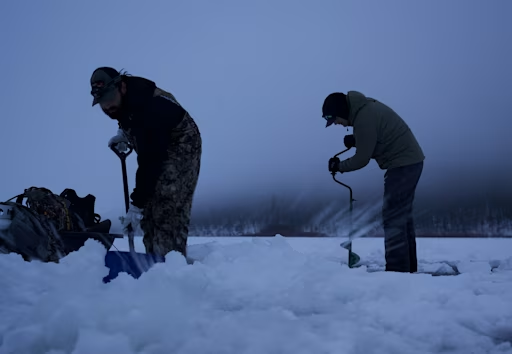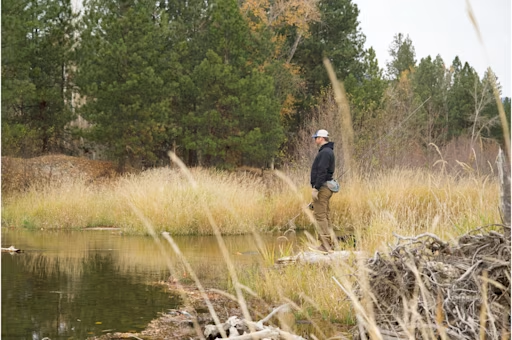Kayak Fishing tips with Chuck Earls
An introduction into the gear and knowledge needed for kayaking America's Great Lakes. Learn about fishing for walleye, steelhead, small mouth bass and other species from a kayak in The Great Lakes.
Share this article

The Great Lakes act as oceans to Midwest and Upper Midwest anglers who don't have the luxury of nearby saltwater to fish. The 4,500 miles of coastline on the lakes offers more area to fish than the Atlantic coastline and continental Pacific coastline combined. The real opportunities to fish, to truly experience these wonders you should take to the water. Watercraft of all sizes, from commercial barges to 12 foot outboard skiffs, travel the Great Lakes but, for the average angler, kayak fishing can prove extremely effective.
Specific areas offer safer paddling than others and special precautions must be taken, but multiple species of gamefish are available from the bow of your kayak.
Chuck Earls is the owner and operator of Lake Erie Kayak Fishing, a guide service that specializes in taking people kayak fishing on the lake.
Earls says the fishing opportunities are near endless on Lake Erie and there are areas for every skill level.
The only time of year Earls doesn’t kayak fish on the lake is when it's frozen over.
This means special precautions and gear are needed for pre-freeze and post thaw times of year, however.

Great Lake Safety
Kayak fishing on the Great Lakes should be taken with the same seriousness as the ocean. Rogue storms, large waves, lightning storms and careless boaters are all factors to prepare for and can be found on almost any day.
Earls suggests using a boat no shorter than 12 feet.
“The big thing is when you get out there with waves coming in one way and boat wakes coming the other way you get into a boat control issue,” Earls said. “Your larger boats are going to track a lot better and run the waves the way you should.
Personal flotation devices are essential gear any time you put your kayak in the water, but you will need special safety gear as well.
Earls suggests attaching foam pool noodles inside your hull as extra flotation in case of emergency.
“This could make all the difference in your boat staying afloat if you get a crack or some other hull damage,” he said. “If you do need to be rescued the noodles will keep your boat afloat, creating a larger target for rescuers.”
Signaling devices, radios and even a dry suit can be necessary for dealing with the unpredictability of the Great Lakes. Up to date weather forecasts, like the kind you can find on your Fishbrain App, are also a must as weather on the lakes can be unpredictable at best.
Other gear can be specific to the time of year and area you are fishing, but overall it is difficult to be too prepared for a day on the Great Lakes.
Recommended Gear:
Dry Suit for post freeze and late summer/fall conditions (Water Temps Can Easily Be In The 50s)
“Six months out of the year you should be in a dry suit," Earls said.
Signaling Whistle Attached to PFD
PFD Type 3 or 5 with knife attached
Airhorn
GPS Unit/Fishbrain Maps
Dry Bags, or Boxes, for Waterproof Storage
Safety Flags
Storms can appear out of nowhere on The Great Lakes and glassy water can turn into three foot waves before you realize. It’s always better to have this gear and not need it. Along with the gear, you need to be hyper aware of your skill levels so as to not get caught a mile offshore.
Stick To the Safe Waters
If you’re not comfortable with heading miles out onto the open water (and many of us aren’t) there are plenty of safe havens to paddle around, in each lake.
Earls suggests using these calmer areas to target walleye, but also to get used to dealing with boat traffic and the wakes created by it.
The West Bay of Lake Erie, for example, is one of the shallowest sections of the lake, close to the mouth of the Maumee River. The West Bay area also has several islands like Catawba Island and Kelleys Island that anglers can fish near. The islands provide good habitat for smallmouth bass and walleye, but also offer protection from incoming winds.
Other calm paddling areas like Saginaw bay in Lake Huron, or Sodus Bay and Port Bay in Lake Ontario offer shelter and calmer shorelines without getting too far from land.
Sticking close to docks is also a viable option for staying safe and targeting inshore species like smallouth, perch and other panfish.

Offshore
Those brave and skilled enough for deepwater, offshore fishing can target some of the more iconic species of The Great Lakes, like salmon, lake trout and steelhead. To do so will require extra gear like a downrigger, jet divers and dipsy divers to get your baits at least 50-60 feet deep where these fish live. Foldable fishing nets, and long handled dehooking tools are also recommended to minimize you bending over the side of your boat to deal with your fish.
Outside of tools, the offshore angler is going to watch their weather forecast like a hawk. A drysuit may be mandatory, not just for the possibility of capsizing, but for the general splashing while being that far from shore.
Species to Target
Lake Erie, where Earls guides out of, is known as the walleye capital. Along with walleye, however, Earls will target steelhead. Smallmouth and smaller panfish can be caught closer to inshore and in the rivers, but the steelhead and walleye are primary targets for Earls.
Steelhead prefer cold water and can be found in shallower waters during late fall and even winter, while in the summer the species live in much deeper waters. This makes catching them tricky. Steelhead prefer cold water and give a terrific fight, but fighting a good size steelhead and bringing it up into high, warm water can be a death sentence for the fish.
So if you plan to keep your steelhead, summer months with downriggers and True Trips weights can be an affective and safer method than risking the winter.
Walleye on the other hand inhabit most depths on the lake and can be readily found in the calmer rivers when they go to spawn.
When fishing in the deeper sections of the lake, Earls suggests using True trips and snap weights when fishing for bigger walleye 40-50 feet deep.
With the proper knowledge, skill and gear a kayak can be the average angler’s ticket to some excellent fishing on The Great Lakes. Rogue weather and boat traffic need to be considered and expected before making a cast, but when you’re prepared, some of the most productive fisheries in the country will be your new fishing playground.
“I’m not one to say you can't do something because you’re gonna die,” Earls said. “I say wait a minute, let's figure out how we can do this.”
YOu can check out more of Chuck Earls' kayak fishing adventures through his videos posted below:
Part 1 - https://youtu.be/ptIcv-5EgqM
Part 2 - https://youtu.be/RjxPZR74H-w
Part 3 - https://youtu.be/ECZbROmXkSY

Download the Fishbrain app and access the best fishing spots in your area
Related blog posts
Master the hardwater season with advanced ice fishing tips . Learn how to find fish faster, refine your search and adjust presentations to catch more fish all winter long.

Your guide to Victoria’s best fish to catch in rivers, lakes, and coastal waters. Learn prime species, fishing tips, and key regulations

Learn how fish adapt as water temperatures cool from autumn to winter, including changes in behavior, metabolism, and habitat that help them survive.




